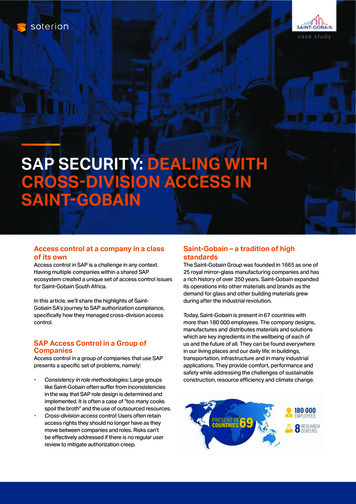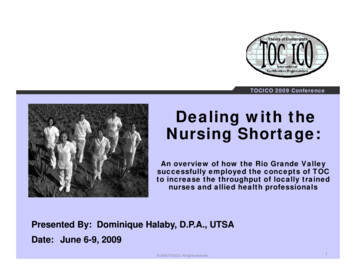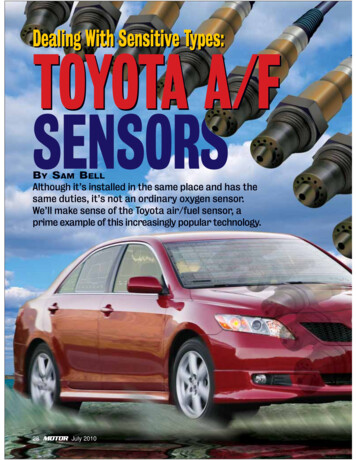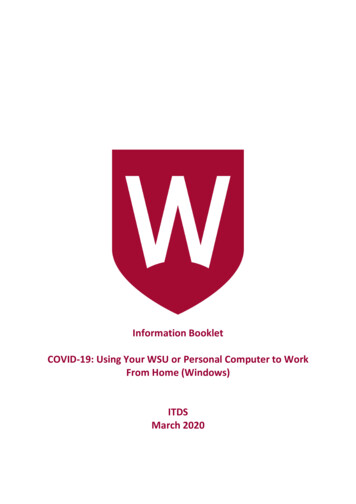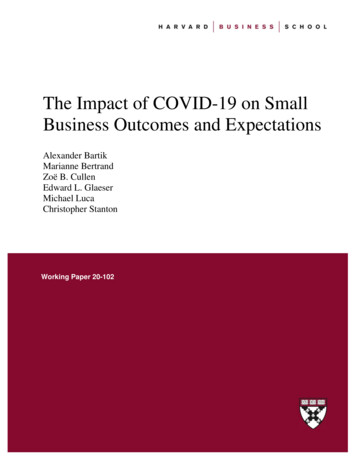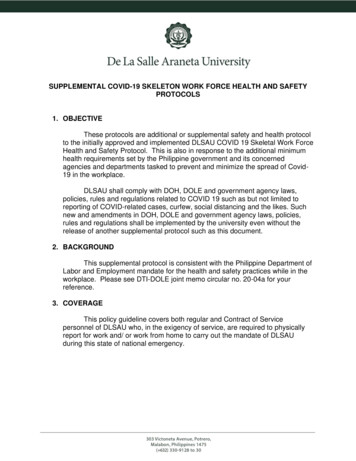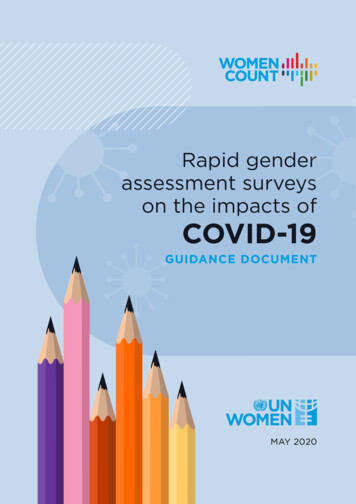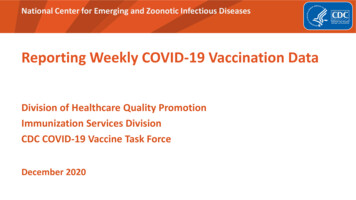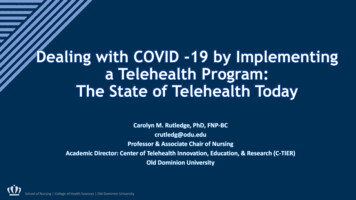
Transcription
Dealing with COVID -19 by Implementinga Telehealth Program:The State of Telehealth TodayCarolyn M. Rutledge, PhD, FNP-BCcrutledg@odu.eduProfessor & Associate Chair of NursingAcademic Director: Center of Telehealth Innovation, Education, & Research (C-TIER)Old Dominion UniversitySchool of Nursing College of Health Sciences Old Dominion University
Objectives This presentation will address: the role of telehealth in addressing issues surrounding COVID-19 andbeyond. curricular development in this time of crisis Participants will learn: how telehealth is being used; the steps needed to implement/provide a telehealth program; rules and regulations that have changed to expand telehealthservices and loosen restrictions; reimbursement; and issues that must be taken into considered such as selecting aplatform, consent, and more.School of Nursing College of Health Sciences Old Dominion University
Impact of Presentation Help those involved in moving clinical practice to TH deliveryunderstand: Legal and regulatory changes Steps to accomplishing a successful transition Help those providing clinical student experiences understand: How clinical encounters can be established What counts for clinical hours Offer suggestions on NP educational content that is neededSchool of Nursing College of Health Sciences Old Dominion University
Purpose of Telehealth Identify and treat patients with COVID-19 symptoms/diagnosis Protect Patients/Populations from COVID-19 Protect Providers from developing COVID-19 Continuing care for existing patients Treating acute patientsSchool of Nursing College of Health Sciences Old Dominion University
Identify Prior to Starting Program Patient Population (demographics, healthcare issues, site thatdelivery will occur from, patient site) Service(s) that will be delivered Synchronous (videoconferencing with or without peripherals) Asynchronous (text, emails, imaging, Remote Patient Monitoring Equipment you will use (existing, free, purchased) Personnel that will be involved Administrative Provider Information TechnologySchool of Nursing College of Health Sciences Old Dominion University
Type Telehealth Program Videoconferencing with and without Peripherals Asynchronous (Store-and-Forward) eVisits Text Hospital-based Ambulatory Remote Patient Monitoring Tele-consultation (specialist) Phone Calls (not TH)School of Nursing College of Health Sciences Old Dominion University
Develop Protocols Contacting patients – Patients need to know that you can manage themvia telehealth. Who will contact them? How will you contact them?What will be their process for contacting you? Obtaining consent – How will consent be obtained/ recorded? Whatpersonnel will be involved? Steps for patients to connect for encounter. Should include informationon steps to take if get disconnected. Send to patient prior to encounter. Providing the visit to outline the provider’s steps for conducting the visit(will outline later in presentation) Handling emergencies including obtaining the address where they arelocated and name and number of emergency contactSchool of Nursing College of Health Sciences Old Dominion University
Before Encounter Practice and become comfortable with the Equipment Learn about Telehealth Etiquettehttps://www.youtube.com/watch?v YVJOesPIdc4&list PLM0VF0yZsE6f6737BT0QdUp7iC9BMINyC&index 2 Test the equipment to make sure there are no complicationsHave patient test the connection from their site.Be sure to have IT available if possibleMake sure you have the consent for the visit if needed (youmay need to check with your state to see if a written consent ifneeded)School of Nursing College of Health Sciences Old Dominion University
Beginning of Encounter Purpose of Encounter – Why you are conducting the visit? Consent - Does patient agree with purpose and agree toparticipate? (Document in chart) Identify those at Each Site - Ask patient who is with them and if itis ok for them to stay for the visit. May have patients and providershow identification especially if you have not met them. Discuss Security – Assure patient that their information will besecure. Let them know how security is maintained. Outline Session – Let patient know what to expect. Equipment Expectations – Explain what to expect of equipmentand what to do if connection is lost.School of Nursing College of Health Sciences Old Dominion University
Conducting Encounter Obtain History/Subjective – Maintaining same standards of care asan in-person visit. Obtain Clinical Data Use creative strategiesUse observational skillsHave patient and/or family assist in gathering dataUse devices/objects found in the home (i.e., flashlight) Examples ENT CHF DM End encounter – Provide a plan, set up referral, send notes/textssecure emailSchool of Nursing College of Health Sciences Old Dominion University
Examples of Current Telehealth Physical Assessment and treatment School healthFQHCsSt. JudeStroke Management Behavioral Mental Health Counseling Education on behavior changes Monitoring RPMSchool of Nursing College of Health Sciences Old Dominion University
Medicare (1135 Waiver) Patients No longer rural or medically underserved area requirements No longer need to be located at a healthcare site No longer need prior relationship with provider Can be treated for any condition HIPAA-Compliant Platforms have been waived Live audio/visual connections is still required Billing codes - Medicare’s Telehealth Fact Sheet (Ref) for codes Copays may be reduced or waived, however, practices are notrequired to waive the copay Coverage at the same rate as in-person visits Out-of-state licensing requirements are temporarily waivedSchool of Nursing College of Health Sciences Old Dominion University
Medicaid Medicaid is regulated at the state level. State Medicaid programs are being asked by CMS to waivecurrent telehealth restrictions. Many states have responded and removed some of theexisting barriers to telehealth, however, each state isdifferent. Providers should check with the Medicaid program in theirstate in order to remain compliant with their state’s Medicaidtelehealth waivers.School of Nursing College of Health Sciences Old Dominion University
Commercial Payers Commercial payers can set their own rules regardingcoverage for telehealth. The American Medical Association is requesting manycommercial providers to remove barriers to providingtelehealth services that are not currently covered. Some commercial payers are still requiring co-signatures forNP’s Providers should check with the payers that cover theirpatients in order to understand their coverageSchool of Nursing College of Health Sciences Old Dominion University
Ryan Haight Act The Drug Enforcement Administration (DEA) has releasedguidance allowing DEA-registered practitioners to issueprescriptions for controlled substances without an initial inperson medical evaluation. Prescription must be issued for a legitimate medical purpose inaccordance with how providers would act in their usual course ofpractice The telemedicine must be done using an audio-visual, real-time twoway communication The practitioner must be acting in accordance with applicable Federaland State law Be sure to obtain identificationSchool of Nursing College of Health Sciences Old Dominion University
Student Clinical Experiences Expectations are for all NP students to have 500 supervised directpatient care clinical hours. For tracks that require more than 500, the remaining hours may bedone through simulation. It is the responsibility of the program to determine if the studentsmeets the competencies for the program. If a student has achieved the direct supervised clinical hours and candemonstrate having met the competencies to provide care, you donot need to acquire additional .pdfSchool of Nursing College of Health Sciences Old Dominion University
Student Clinical using Telehealth Clinical hours may be achieved through telehealth encountersthe same as in-person hours Requirements that must be met include: Patient care is being provided A preceptor or faculty member is participating in the visit (SupervisedDirect Patient Care) Same standard of care is being expected as in person visit Student is involved in the provision of care at the level they would beexpected during an in-person visit Visit may be done using videoconferencing alone or with peripherals,eConsults, EVisitsSchool of Nursing College of Health Sciences Old Dominion University
Telehealth Education Educational strategies that can be provided to assist students in acquiring the KSAs fortelehealth ectsRutledge, C. M., Kott, K., Schweickert, P., Poston, R., Fowler, C., Haney, T.(2017). “Telehealth and eHealth in Nurse Practitioner Training: CurrentPerspectives”. Advances in Medical Educations and Practice. 8, 399-409.ClinicalRotationsSchool of Nursing College of Health Sciences Old Dominion University
Support for Telehealth Education HRSA National Telehealth Education Toolkit O'Rourke, Jenny jorourke1@luc.edu Reynolds, Elizabeth ereynolds4@luc.edu Telehealth Resource Centers https://www.telehealthresourcecenter.org/ Faculty Collaboration Telehealth Certification Programs Telehealth Centers (C-TIER) Text “Telehealth Essentials for Advanced Practice Nurses” dueout in JulySchool of Nursing College of Health Sciences Old Dominion University
References Rutledge, C.M., Pitts, C., Poston, R. & Schweickert, P. (2018). National Organization of Nurse Practitioner Faculty (NONPF) Position Paper:Telehealth in Nurse Practitioner Education. (Guidelines for the role of telehealth in nurse practitioner resource/resmgr/2018 Slate/Telehealth Paper 2018.pdf Statement Regarding Nurse Practitioner Students and Direct Care Clinical Hours. Released March 23, .pdf Medicare Telemedicine Fact Sheet. telemedicine-health-care-provider-fact-sheet CMS expands Medicare telehealth services to fight COVID-19. nds-medicaretelehealth-services-fight-covid-19 CMS shares specifics on sweeping Medicare telehealth expansion. cs-on-sweepingmedicare-telehealth-expansion/?rf 1 Telehealth Etiquette. https://www.youtube.com/watch?v YVJOesPIdc4&list PLM0VF0yZsE6f6737BT0QdUp7iC9BMINyC&index 2 Rutledge, C. M., Kott, K., Schweickert, P., Poston, R., Fowler, C., Haney, T. (2017). “Telehealth and eHealth in Nurse Practitioner Training: CurrentPerspectives”. Advances in Medical Educations and Practice. 8, 399-409. The National Resource Center with links to the regional center. https://www.telehealthresourcecenter.org/ Schweickert, P., Rheuban, K., Wiles, L., Fowler, C., Haney, T., Rutledge, C.M. (2018). “The APN-PLACE Telehealth Education Network: Legal andRegulatory Considerations for Telehealth Enhanced Clinical Education”. Journal of Nurse Regulations. State Policy Resource Center. (n.d.). Retrieved April 2017, from -resource-center Blog on Current Status of Telehealth - 7 steps to starting telehealth elehealth-programcovid-19-solutions/ Blog on Providing Telehealth in Time of Crisis s-time-of-crisis-removing-barriers/School of Nursing College of Health Sciences Old Dominion University
Questions?School of Nursing College of Health Sciences Old Dominion University
a Telehealth Program: The State of Telehealth Today Carolyn M. Rutledge, PhD, FNP-BC crutledg@odu.edu Professor & Associate Chair of Nursing Academic Director: Center of Telehealth Innovation, Education, & R
